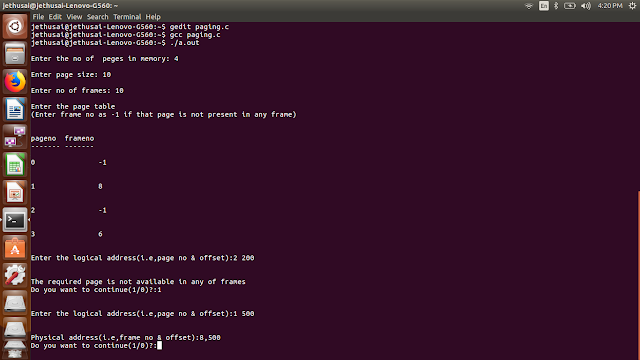CPU Scheduling
CPU Scheduling
CPU scheduling is a
process which allows one process to use the CPU while the execution of another
process is on hold(in waiting state) due to unavailability of any resource like
I/O etc, thereby making full use of CPU. The aim of CPU scheduling is to make
the system efficient, fast and fair.
Whenever the CPU becomes
idle, the operating system must select one of the processes in the ready queue
to be executed. The selection process is carried out by the short-term
scheduler (or CPU scheduler). The scheduler selects from among the processes in
memory that are ready to execute, and allocates the CPU to one of them.
Dispatcher
Another component
involved in the CPU scheduling function is the dispatcher. The
dispatcher is the module that gives control of the CPU to the process selected
by the short-term scheduler. This function involves:
·
Switching context
·
Switching to user mode
·
Jumping to the proper
location in the user program to restart that program
The dispatcher should be
as fast as possible, given that it is invoked during every process switch. The
time it takes for the dispatcher to stop one process and start another running
is known as the dispatch latency. Dispatch Latency can be explained
using the below figure:
Types of CPU Scheduling
CPU scheduling decisions
may take place under the following four circumstances:
1.
When a process switches
from the running state to the waiting state(for
I/O request or invocation of wait for the termination of one of the child
processes).
2.
When a process switches
from the running state to the ready state
(for example, when an interrupt occurs).
3.
When a process switches
from the waiting state to the ready state(for
example, completion of I/O).
4.
When a process terminates.
In circumstances 1 and
4, there is no choice in terms of scheduling. A new process(if one exists in
the ready queue) must be selected for execution. There is a choice, however in
circumstances 2 and 3.
When Scheduling takes
place only under circumstances 1 and 4, we say the scheduling scheme is non-preemptive;
otherwise the scheduling scheme is preemptive.
Non-Preemptive Scheduling:
Under non-preemptive
scheduling, once the CPU has been allocated to a process, the process keeps the
CPU until it releases the CPU either by terminating or by switching to the
waiting state.
This scheduling method
is used by the Microsoft Windows 3.1 and by the Apple Macintosh operating
systems.
It is the only method
that can be used on certain hardware platforms, because It does not require the
special hardware(for example: a timer) needed for preemptive scheduling.
Preemptive Scheduling:
In this type of
Scheduling, the tasks are usually assigned with priorities. At times it is
necessary to run a certain task that has a higher priority before another task although
it is running. Therefore, the running task is interrupted for some time and
resumed later when the priority task has finished its execution.


Comments
Post a Comment